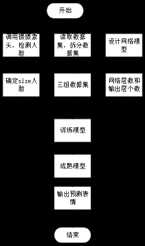标签:models mode min lis 神经网络 uil 图片 public mil
首先非常感谢 zhouzaihang:https://www.52pojie.cn/forum.php?mod=viewthread&tid=863608
环境:python、python-opencv、keras、tensorflow
其他库,可以安装anaconda,差不多的库都装好了的。
训练数据:fer2013.csv
下载地址:链接:https://pan.baidu.com/s/1Ac5XBue0ahLOkIXwa7W77g 提取码:qrue

总流程:

第一步:数据预处理:fer2013.csv = train.csv +test.csv +val.csv ;同时还原出图像数据。
标签emotion_labels = [‘angry‘, ‘disgust‘, ‘fear‘, ‘happy‘, ‘sad‘, ‘surprise‘, ‘neutral‘]对应0-6命名的文件夹。
代码:
import csv
import os
from PIL import Image
import numpy as np
# 读、写数据的地址
data_path = os.getcwd() + "/data/"
csv_file = data_path + ‘fer2013.csv‘ # 读数据集地址
train_csv = data_path + ‘train.csv‘ # 拆数据集保存地址
val_csv = data_path + ‘val.csv‘
test_csv = data_path + ‘test.csv‘
# csv文件像素保存为图像的文件夹名称
train_set = os.path.join(data_path, ‘train‘)
val_set = os.path.join(data_path, ‘val‘)
test_set = os.path.join(data_path, ‘test‘)
# 开始整理数据集:读
with open(csv_file) as f:
csv_r = csv.reader(f)
header = next(csv_r)
print(header)
rows = [row for row in csv_r]
trn = [row[:-1] for row in rows if row[-1] == ‘Training‘]
csv.writer(open(train_csv, ‘w+‘), lineterminator=‘\n‘).writerows([header[:-1]] + trn)
print(len(trn))
val = [row[:-1] for row in rows if row[-1] == ‘PublicTest‘]
csv.writer(open(val_csv, ‘w+‘), lineterminator=‘\n‘).writerows([header[:-1]] + val)
print(len(val))
tst = [row[:-1] for row in rows if row[-1] == ‘PrivateTest‘]
csv.writer(open(test_csv, ‘w+‘), lineterminator=‘\n‘).writerows([header[:-1]] + tst)
print(len(tst))
for save_path, csv_file in [(train_set, train_csv), (val_set, val_csv), (test_set, test_csv)]:
if not os.path.exists(save_path):
os.makedirs(save_path)
num = 1
with open(csv_file) as f:
csv_r = csv.reader(f)
header = next(csv_r)
for i, (label, pixel) in enumerate(csv_r):
# 0 - 6 文件夹分别label为:
# angry ,disgust ,fear ,happy ,sad ,surprise ,neutral
pixel = np.asarray([float(p) for p in pixel.split()]).reshape(48, 48)
sub_folder = os.path.join(save_path, label)
if not os.path.exists(sub_folder):
os.makedirs(sub_folder)
im = Image.fromarray(pixel).convert(‘L‘)
image_name = os.path.join(sub_folder, ‘{:05d}.jpg‘.format(i))
print(image_name)
im.save(image_name)
第二部:训练网络,得到分类器模型。
定义Model共20层:深度卷积神经网络的构建和训练。
卷积层conv2D +激活层activation-relu +conv2D + activation-relu +池化层MaxPooling2D +
conv2D + activation-relu + MaxPooling2D +
conv2D + activation-relu + MaxPooling2D +
扁平Flaten + 全连接层Dense + activation-relu +
丢失部分特征Dropout + Dense + activation-relu +
Dropout + Dense + activation-relu
保存网络.json和 模型.h5
流程:

train.py
from keras.layers import Dense, Dropout, Activation, Flatten, Conv2D, MaxPooling2D
from keras.models import Sequential
from keras.preprocessing.image import ImageDataGenerator
from keras.optimizers import SGD
batch_siz = 128
num_classes = 7
nb_epoch = 100
img_size = 48
data_path = ‘./data‘
model_path = ‘./model‘
class Model:
def __init__(self):
self.model = None
def build_model(self):
self.model = Sequential()
self.model.add(Conv2D(32, (1, 1), strides=1, padding=‘same‘, input_shape=(img_size, img_size, 1)))
self.model.add(Activation(‘relu‘))
self.model.add(Conv2D(32, (5, 5), padding=‘same‘))
self.model.add(Activation(‘relu‘))
self.model.add(MaxPooling2D(pool_size=(2, 2))) #池化,每个块只留下max
self.model.add(Conv2D(32, (3, 3), padding=‘same‘))
self.model.add(Activation(‘relu‘))
self.model.add(MaxPooling2D(pool_size=(2, 2)))
self.model.add(Conv2D(64, (5, 5), padding=‘same‘))
self.model.add(Activation(‘relu‘))
self.model.add(MaxPooling2D(pool_size=(2, 2)))
self.model.add(Flatten()) # 扁平,折叠成一维的数组
self.model.add(Dense(2048)) # 全连接神经网络层
self.model.add(Activation(‘relu‘))
self.model.add(Dropout(0.5)) # 忽略一半的特征检测器
self.model.add(Dense(1024))
self.model.add(Activation(‘relu‘))
self.model.add(Dropout(0.5))
self.model.add(Dense(num_classes))
self.model.add(Activation(‘softmax‘))
self.model.summary() # 参数输出
def train_model(self):
sgd = SGD(lr=0.01, decay=1e-6, momentum=0.9, nesterov=True) #随机梯度下降的方向训练权重
self.model.compile(loss=‘categorical_crossentropy‘, optimizer=sgd, metrics=[‘accuracy‘])
# 自动扩充训练样本
train_datagen = ImageDataGenerator(
rescale=1. / 255,
shear_range=0.2,
zoom_range=0.2,
horizontal_flip=True)
# 归一化验证集
val_datagen = ImageDataGenerator(
rescale=1. / 255)
eval_datagen = ImageDataGenerator(
rescale=1. / 255)
# 以文件分类名划分label
train_generator = train_datagen.flow_from_directory(
data_path + ‘/train‘,
target_size=(img_size, img_size),
color_mode=‘grayscale‘,
batch_size=batch_siz,
class_mode=‘categorical‘)
val_generator = val_datagen.flow_from_directory(
data_path + ‘/val‘,
target_size=(img_size, img_size),
color_mode=‘grayscale‘,
batch_size=batch_siz,
class_mode=‘categorical‘)
eval_generator = eval_datagen.flow_from_directory(
data_path + ‘/test‘,
target_size=(img_size, img_size),
color_mode=‘grayscale‘,
batch_size=batch_siz,
class_mode=‘categorical‘)
# early_stopping = EarlyStopping(monitor=‘loss‘, patience=3)
history_fit = self.model.fit_generator(
train_generator,
steps_per_epoch=800 / (batch_siz / 32), # 28709
nb_epoch=nb_epoch,
validation_data=val_generator,
validation_steps=2000,
# callbacks=[early_stopping]
)
# history_eval=self.model.evaluate_generator(
# eval_generator,
# steps=2000)
history_predict = self.model.predict_generator(
eval_generator,
steps=2000)
with open(model_path + ‘/model_fit_log‘, ‘w‘) as f:
f.write(str(history_fit.history))
with open(model_path + ‘/model_predict_log‘, ‘w‘) as f:
f.write(str(history_predict))
# 保存训练的模型文件
def save_model(self):
model_json = self.model.to_json()
with open(model_path + "/model_json.json", "w") as json_file:
json_file.write(model_json)
self.model.save_weights(model_path + ‘/model_weight.h5‘)
self.model.save(model_path + ‘/model.h5‘)
if __name__ == ‘__main__‘:
model = Model()
model.build_model()
print(‘model built‘)
model.train_model()
print(‘model trained‘)
model.save_model()
print(‘model saved‘)
第三步:使用模型,预测表情。
predictFER.py
#!/usr/bin/python
# -*- coding = utf-8 -*-
#author:thy
#date:20191230
#version:1.0
import cv2
import numpy as np
from keras.models import model_from_json
model_path = ‘./model/‘
img_size = 48
emotion_labels = [‘angry‘, ‘disgust‘, ‘fear‘, ‘happy‘, ‘sad‘, ‘surprise‘, ‘neutral‘]
num_class = len(emotion_labels)
# 从json中加载模型
json_file = open(model_path + ‘model_json.json‘)
loaded_model_json = json_file.read()
json_file.close()
model = model_from_json(loaded_model_json)
# 加载模型权重
model.load_weights(model_path + ‘model_weight.h5‘)
# 创建VideoCapture对象
capture = cv2.VideoCapture(0)
# 使用opencv的人脸分类器
cascade = cv2.CascadeClassifier(model_path + ‘haarcascade_frontalface_alt.xml‘)
while True:
ret, frame = capture.read()
# 灰度化处理
gray = cv2.cvtColor(frame, cv2.COLOR_BGR2GRAY)
# 呈现用emoji替代后的画面
emoji_show = frame.copy()
# 识别人脸位置
faceLands = cascade.detectMultiScale(gray, scaleFactor=1.1,
minNeighbors=1, minSize=(120, 120))
if len(faceLands) > 0:
for faceLand in faceLands:
x, y, w, h = faceLand
images = []
result = np.array([0.0] * num_class)
# 裁剪出脸部图像
image = cv2.resize(gray[y:y + h, x:x + w], (img_size, img_size))
image = image / 255.0
image = image.reshape(1, img_size, img_size, 1)
# 调用模型预测情绪
predict_lists = model.predict_proba(image, batch_size=32, verbose=1)
# print(predict_lists)
result += np.array([predict for predict_list in predict_lists
for predict in predict_list])
# print(result)
emotion = emotion_labels[int(np.argmax(result))]
print("Emotion:", emotion)
# 框出脸部并且写上标签
cv2.rectangle(frame, (x - 20, y - 20), (x + w + 20, y + h + 20),
(0, 255, 255), thickness=10)
cv2.putText(frame, ‘%s‘ % emotion, (x, y - 50),
cv2.FONT_HERSHEY_DUPLEX, 2, (255, 255, 255), 2, 30)
cv2.imshow(‘Face‘, frame)
if cv2.waitKey(60) == ord(‘q‘):
break
# 释放摄像头并销毁所有窗口
capture.release()
cv2.destroyAllWindows()
结论:
实现摄像头检测到的人脸的表情标记。

标签:models mode min lis 神经网络 uil 图片 public mil
原文地址:https://www.cnblogs.com/philothypeipei/p/12122149.html